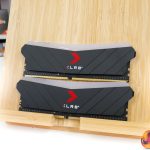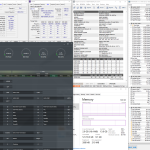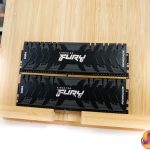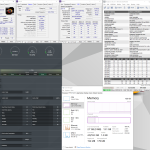We will be outlining the DDR4 memory kits' performance with the AMD Ryzen 9 5950X CPU, ASUS ROG Crosshair VIII Hero motherboard, and a Gigabyte RTX 3080 Eagle OC graphics card. The processor is overclocked to a static 4.6GHz to take any clock speed variability from Precision Boost 2 out of the performance equation.
By default on AMD, 4000MHz memory will deliver a 2000MHz memory clock and therefore a 1000MHz memory controller clock due to the 2:1 divider. In fact, any memory speed beyond 3600MHz will drop the memory controller clock to a 2:1 divider without manual intervention.
If, however, we can get the Infinity Fabric clock to match the memory clock, we can also run the memory controller clock at the same speed and remove the 2:1 divider latency penalty. Unfortunately, our 5950X doesn’t want to seem to go higher than 1900 MHz for the Fabric Clock.
This means that we have two test procedures for 4GHz kits in particular:
- We test the kit at stock 4000MHz XMP with the Ryzen system running without adjustment beyond a 4.6GHz CPU OC. This results in 1800MHz Fabric clock, 2000MHz memory clock, and 1000MHz memory controller clock.
- We also test with the memory running alongside a CPU configuration better tuned for high speed memory. This is 1900MHz Fabric clock, 1900MHz memory clock, and 1900MHz memory controller clock. Here, the memory was running at DDR4-3800MHz speeds.
The 5333MHz Kingston kit is simply too fast to apply such workarounds. We have yet to see an AMD motherboard that highlights memory speeds as high as 5333MHz on the QVL, and even Intel boards that will support 5333MHz are few and far between.
The best stable memory speed that we could achieve on our ASUS ROG Crosshair VIII Hero test motherboard was 4600MHz. This was not a reflection of the Kingston memory kit, but instead highlights some downsides of the AMD platform with respect to high-speed memory.
Given that 4600MHz is well below the 5333MHz rated frequency, we instead opted for the tighter timings of the secondary XMP profile. This had us running the kit at 4600MHz 20-23-23-42 at 1.60V. That is actually a hefty overclock in terms of timings, so it will be interesting to see how this plays out.
We know that testing this set on our go-to AMD platform is not ideal, but we will keep an eye on these sticks when it comes to testing Intel’s 12th Gen Alder Lake CPUs on DDR4-capable motherboards. That could certainly make for some interesting testing to see if uber-high-speed DDR4 in single-rank configuration can outperform more modest frequency dual-rank kits.
Test System:
- Processor: AMD Ryzen 9 5950X overclocked to 4.6GHz all core.
- Motherboard: ASUS ROG Crosshair VIII Hero.
- Graphics Card: Gigabyte RTX 3080 Eagle OC.
- System Drive: WD_Black SN750 SSD.
- CPU Cooler: Fractal Celsius+ S28 Prisma 280mm AIO.
- Power Supply: Seasonic Prime TX-1000 1000W.
- Case: Lian Li Open-air Test Bench.
- Operating System: Windows 10 Pro 64-bit.
Tests:
- 7-Zip – Built-in 7-Zip benchmark test (CPU & Memory)
- Cinebench R23 – All-core CPU benchmark (CPU & Memory)
- Blender 2.93.4 – All-core rendering of the Classroom benchmark (CPU & Memory)
- SiSoft Sandra – Memory bandwidth (Memory)
- AIDA64 – Memory bandwidth, memory latency (Memory)
- 3DMark TimeSpy – Time Spy (1440p) test (Gaming)
- F1 2020 – 1920 x 1080, Ultra High quality preset, DX12 version (Gaming)
- Watch Dogs Legion – 1920 x 1080, Ultra quality preset, DX12 version (Gaming)
 KitGuru KitGuru.net – Tech News | Hardware News | Hardware Reviews | IOS | Mobile | Gaming | Graphics Cards
KitGuru KitGuru.net – Tech News | Hardware News | Hardware Reviews | IOS | Mobile | Gaming | Graphics Cards






